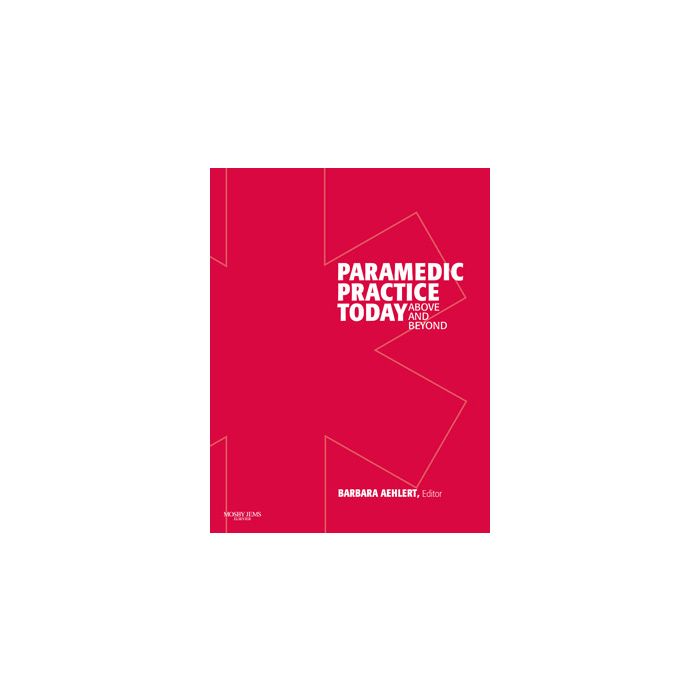Paramedic Practice Today - Volume 1 -Above and Beyond

- ISBN/EAN
- 9780323043748
- Editore
- Elsevier Science
- Formato
- Sconosciuto
- Anno
- 2009
- Pagine
- Pag. 1576 <br> Mosby<br> Hardcover
Disponibile
94,99 €
Providing the tools you need to succeed, Volume 1 of Paramedic Practice Today: Above and Beyond offers a solid foundation for paramedic practice. A conversational, easy-to-read style simplifies topics and helps you master National Standard Curriculum objectives and meet the new National Education Standards. It includes a companion DVD-ROM with step-by-step videos demonstrating the skills in the textbook and more. Because this book corresponds to the National Registry of EMTs National EMS Practice Analysis, it provides you with the best possible preparation for the National Registry exam.
Key Features
-Unique! The new National Education Standards are referenced, as well as the National Standard Curriculum objectives.
Unique! This textbook addresses the tasks in the NREMT 2004 National EMS Practice Analysis, which is the foundation for the NREMT exam.
Four-part case scenarios appear in each chapter, and emphasize patient comfort and care: 1) an introduction sets up the scenario and asks questions, 2) the scenario continues, following the treatment of the patient and asking more questions, 3) the conclusion resolves the scenario and asks more questions, looking back on decisions that you’ve made, and 4) the summary answers all of the questions presented in parts 1-3.
35 skill sequences show each action with illustrated, step-by-step instructions.
A companion DVD-ROM shows video clips of key skills in the book, along with medical animations, lectures, and skills video clips from other Elsevier titles.
Pediatric Pearl boxes call attention to the differences for pediatric patients.
Geriatric considerations are highlighted in special boxes to draw attention to the differences for elderly patients.
Cultural Considerations boxes highlight helpful tips for interacting with people of various cultures.
Paramedic Pearl boxes highlight important information from the text.
An anatomy and physiology review begins chapters as needed, and for specific conditions, those chapters also include a description/definition, etiology, epidemiology and demographics, history, physical findings, differential diagnosis, therapeutic interventions, patient/family education, and prehospital pearls.
Chapter Summaries are bulleted to help you review important information.
Key Terms are defined in the terminology section at the end of each chapter for easy review before exams.
Quizzes end each chapter, with answers and rationales at the back of the textbook.
Unique tools include a plastic heart rate ruler and a laminated 12-lead placement card.
A comprehensive index and 2,222-term glossary cover all the content in Volumes 1 and 2, allowing you to quickly find key terms and topics.
Herbal and drug indexes cover 50 herbal supplements and approximately 100 drugs
Key Features
-Unique! The new National Education Standards are referenced, as well as the National Standard Curriculum objectives.
Unique! This textbook addresses the tasks in the NREMT 2004 National EMS Practice Analysis, which is the foundation for the NREMT exam.
Four-part case scenarios appear in each chapter, and emphasize patient comfort and care: 1) an introduction sets up the scenario and asks questions, 2) the scenario continues, following the treatment of the patient and asking more questions, 3) the conclusion resolves the scenario and asks more questions, looking back on decisions that you’ve made, and 4) the summary answers all of the questions presented in parts 1-3.
35 skill sequences show each action with illustrated, step-by-step instructions.
A companion DVD-ROM shows video clips of key skills in the book, along with medical animations, lectures, and skills video clips from other Elsevier titles.
Pediatric Pearl boxes call attention to the differences for pediatric patients.
Geriatric considerations are highlighted in special boxes to draw attention to the differences for elderly patients.
Cultural Considerations boxes highlight helpful tips for interacting with people of various cultures.
Paramedic Pearl boxes highlight important information from the text.
An anatomy and physiology review begins chapters as needed, and for specific conditions, those chapters also include a description/definition, etiology, epidemiology and demographics, history, physical findings, differential diagnosis, therapeutic interventions, patient/family education, and prehospital pearls.
Chapter Summaries are bulleted to help you review important information.
Key Terms are defined in the terminology section at the end of each chapter for easy review before exams.
Quizzes end each chapter, with answers and rationales at the back of the textbook.
Unique tools include a plastic heart rate ruler and a laminated 12-lead placement card.
A comprehensive index and 2,222-term glossary cover all the content in Volumes 1 and 2, allowing you to quickly find key terms and topics.
Herbal and drug indexes cover 50 herbal supplements and approximately 100 drugs
Maggiori Informazioni
| Autore | Aehlert -RN - BSPA |
|---|---|
| Editore | Elsevier Science |
| Anno | 2009 |
| Tipologia | Libro |
| Lingua | Inglese |
| Indice | Division 1: Preparatory 1. EMS Safety and Well-Being of the Paramedic 2. Paramedic Roles and Responsibilities 3. Illness and Injury Prevention 4. Legal and Regulatory Issues 5. Ethics 6. Medical Terminology Review 7. Body Systems: Anatomy and Physiology 8. Pathophysiology 9. Life Span Development 10. Public Health and EMS Division 2: Pharmacology 11. Basic Principles of Pharmacology 12. Drug and Chemical Classes 13. Medication Administration Division 3: Airway Management and Ventilation 14. Airway and Ventilation Division 4: Patient Assessment 15. Therapeutic Communication 16. History Taking 17. Patient Assessment 18. Communication 19. Documentation Division 5: Medical 20. Head, Ear, Eye, Nose, and Throat Disorders 21. Pulmonary 22. Cardiovascular Disorders 23. Disorders of the Nervous System 24. Endocrine Emergencies and Nutritional Disorders 25. Immune System Disorders 26. Gastrointestinal Disorders 27. Renal and Urogenital Disorders 28. Musculoskeletal Disorders 29. Cutaneous Disorders 30. Toxicology 31. Infectious and Communicable Diseases 32. Psychiatric Disorders and Substance Abuse 33. Hematologic Disorders Division 6: Shock 34. Shock and Resuscitation Appendices A. Quiz Answers B. Drug Profiles C. Herbal Supplements Glossary Illustration Credits |
Questo libro è anche in:
